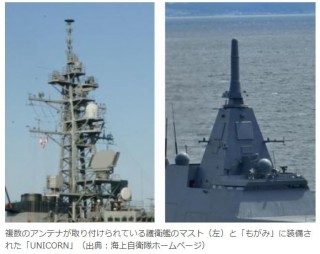Loading
Search
▼ Japan And India Progress Towards UNICORN Stealth Antenna Deal
- Category:Tourism
Japan and India have agreed to proceed with Tokyo’s planned export to New Delhi of the UNICORN integrated stealth antenna system that is currently used for the Mogami-class multirole frigate of the Japanese Maritime Self-Defense Force.
At the third 2+2 ministerial meeting in New Delhi on August 20, foreign and defense ministers from the two nations agreed on a series of measures to enhance their bilateral defense cooperation in defense equipment and joint exercises.
The naval ship communication antenna system, which is set to be exported to India, is called “UNICORN.”
The name stands for “Unified Complex Radio Antenna.”
A joint statement noted that the four ministers “appreciated the progress made for the transfer of Unified Complex Radio Antenna (UNICORN) and related technologies and early signing of related arrangements.”
UNICORN was jointly developed by three Japanese companies, namely NEC Corporation, Sampa Kogyo K.K. and The Yokohama Rubber Co., Ltd., with NEC as the main contractor.
UNICORN (in its NORA-50 variant) is currently fitted on Mogami-class frigates exclusively.
According to Yokohama Rubber’s homepage, UNICORN consolidates various aerials (antennas) that were previously attached to multiple points on a mast on the deck into a single support column in order to improve stealth.
In addition to excellent stealth, the optimal placement of the antennas has improved the maximum detection distance of radio waves emitted from outside, and simplified maintenance and installation processes.
Yokohama Rubber said it was in charge of developing the antenna cover, or radome, that covers the entire UNICORN. Utilizing the technology it has cultivated in developing radomes for aircraft, it maximizes radio wave transparency while also providing basic weather resistance and lightning resistance to protect the antenna from lightning strikes.
Meanwhile, NEC provided its TACAN (Tactical Air Navigation System) antenna design technology and hardware system integration technology.
Sampa Kogyo provided its antenna design technology for shipboard terrestrial communications and its know-how as a company that maintains and repairs shipboard equipment, according to three companies’ press release.
By stacking multiple antennas one on top of the other and covering the entire system with the radome, UNICORN can reduce the radar cross section (RCS) of the antennas, which increases stealth by making it more difficult for any enemy to detect naval vessels.
In contrast, conventional ships have had multiple antennas mounted individually on their masts.
In fiscal year 2023, UNICORN received win the top award from the Defense Structure Improvement Foundation, a public interest incorporated foundation in Japan.
This award is given to individuals or groups who have made particularly outstanding achievements in the development and production of defense equipment, under the sponsorship of Acquisition, Technology & Logistics Agency (ATLA).
UNICORN has a spire-shaped dome that houses many antennas and other equipment.
The UNICORN mast features the following:
- The antennas for Link 16, which is a military tactical data link network used by NATO members and other Western nations.
- TACAN (Tactical Air Navigation System) is an antenna that provides information about the ship’s direction and distance to ship-based helicopters.
- Identification Friend or Foe (IFF) antennas
- ESM (Electronic Support Measures) for radar, or ES-R, which detects radio waves emitted by the seeker of an incoming anti-ship missile.
- ESM for communication, or ES-C, which is used to intercept radio communications. It is believed to be the same function as C-ESM used by European navies.
- UHF/VHF transmitting/receiving antenna, which is an antenna for UHF/VHF wireless communication, is used for short-distance communication.
- ORQ-2B-4 Offshore Wireless Router, which is Wi-Fi bands that provide a means of sharing information when sonar performs bistatic and multi-static detection
The JMSDF plans to build a total of 12 Mogami-class frigates until the fiscal year 2023, with plans to acquire a new class of 12 FFMs from 2024 until 2028.
The new frigates will essentially be improved large Mogami-class ships that are set to be built to the design proposed by MHI. Naval News previously reported on the “New FFM” at this link.
Australia Lists Mogami Class as 1 of 4 Contenders for Its Next Frigate
As part of the Royal Australian Navy’s Tier 2 / SEA3000 requirement, Australia has listed the Mogami-class frigate of the JMSDF as one of the four candidates for the navy’s next frigate, with the other three vessels being Germany’s Meko A-200, South Korea’s Daegu class FFX Batch II and III, and Spain’s Navantia ALFA3000.
- August 28, 2024
- Comment (0)
- Trackback(0)




